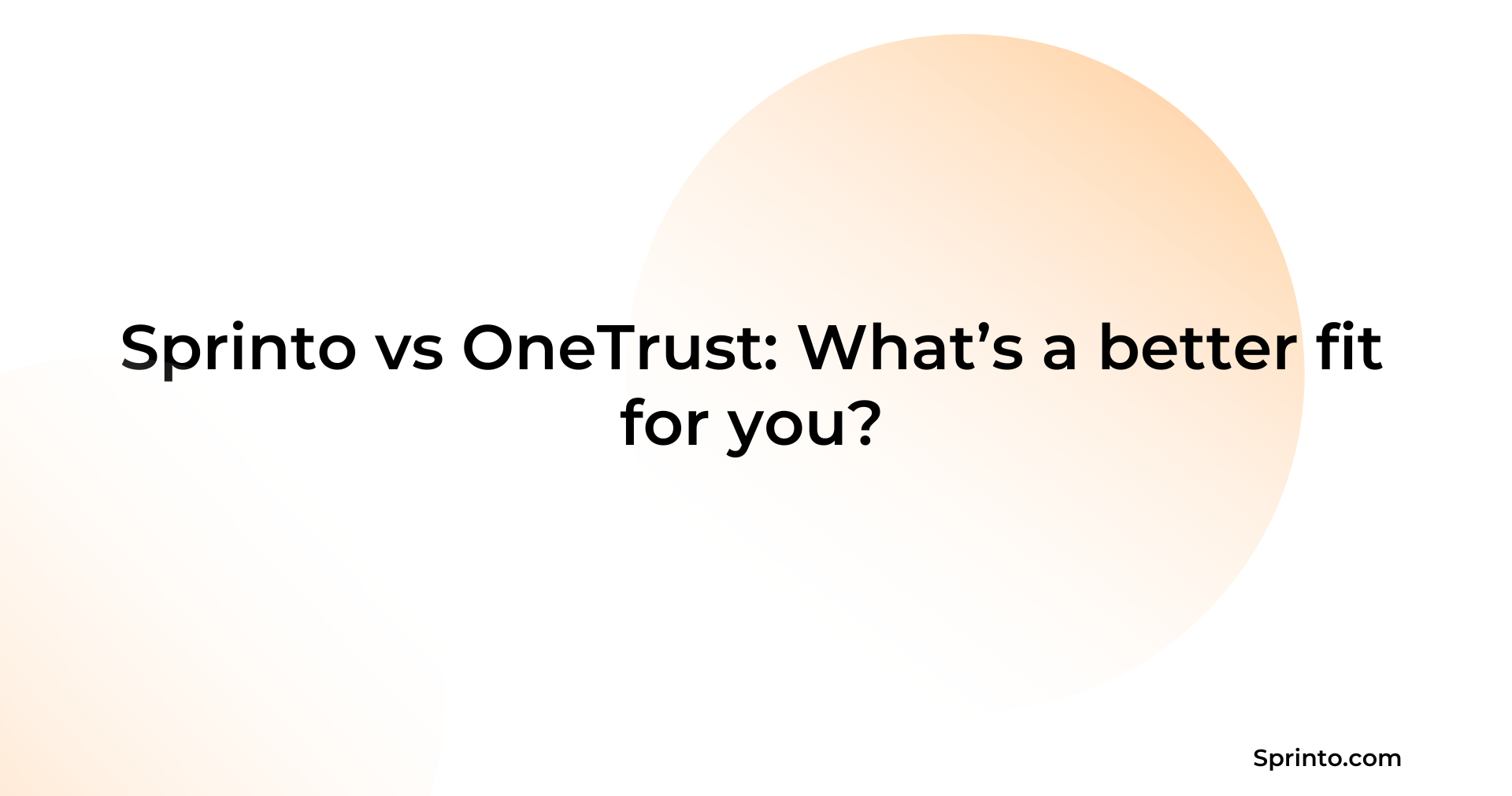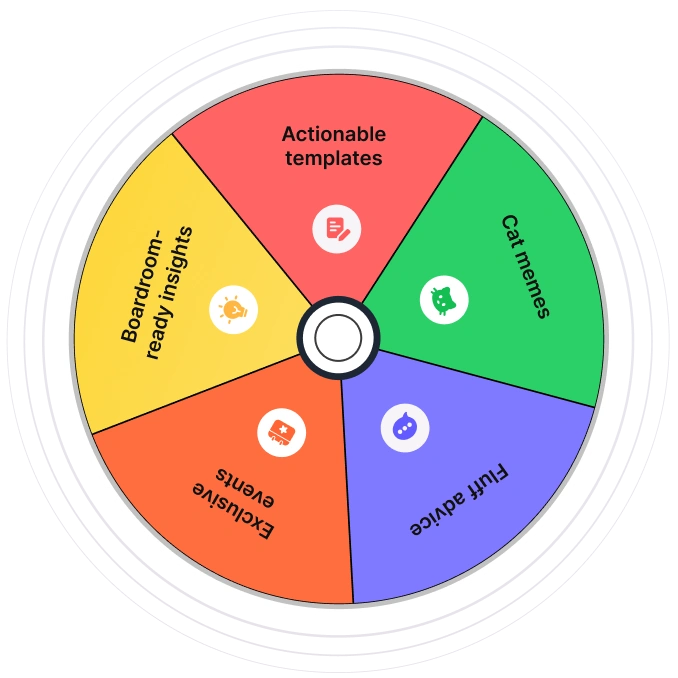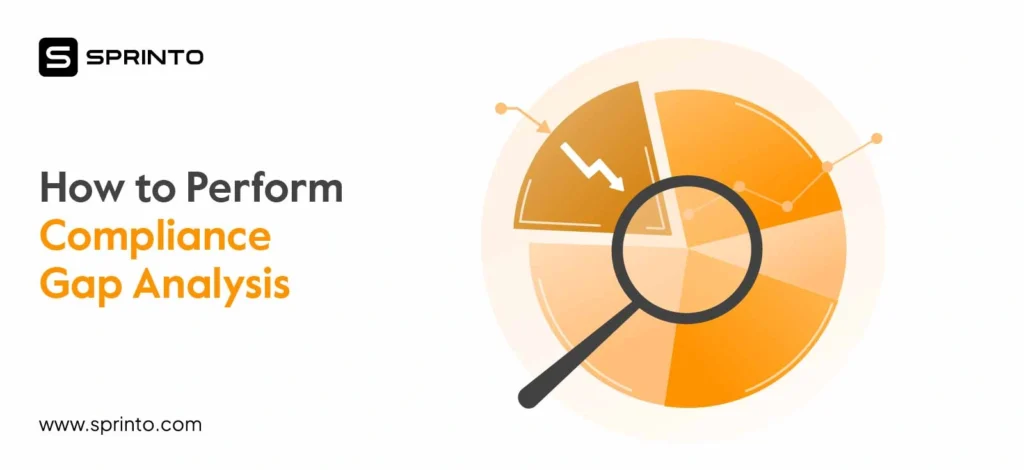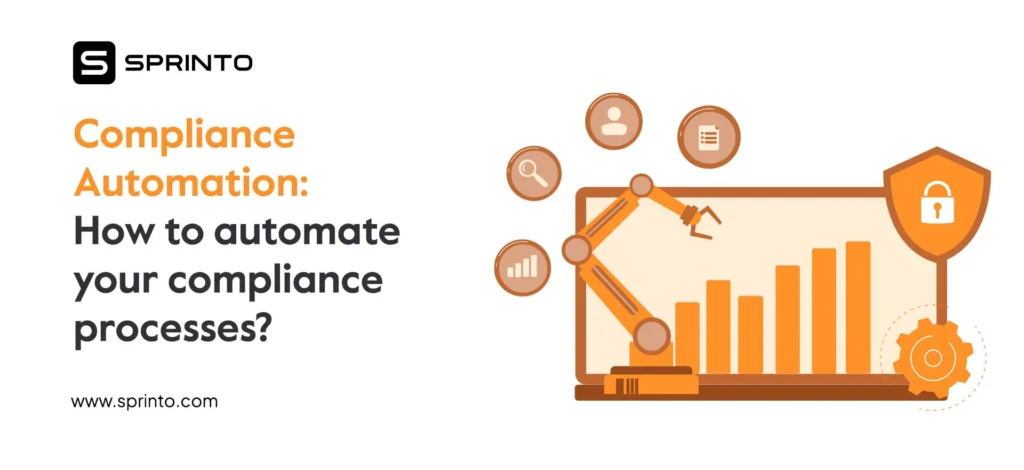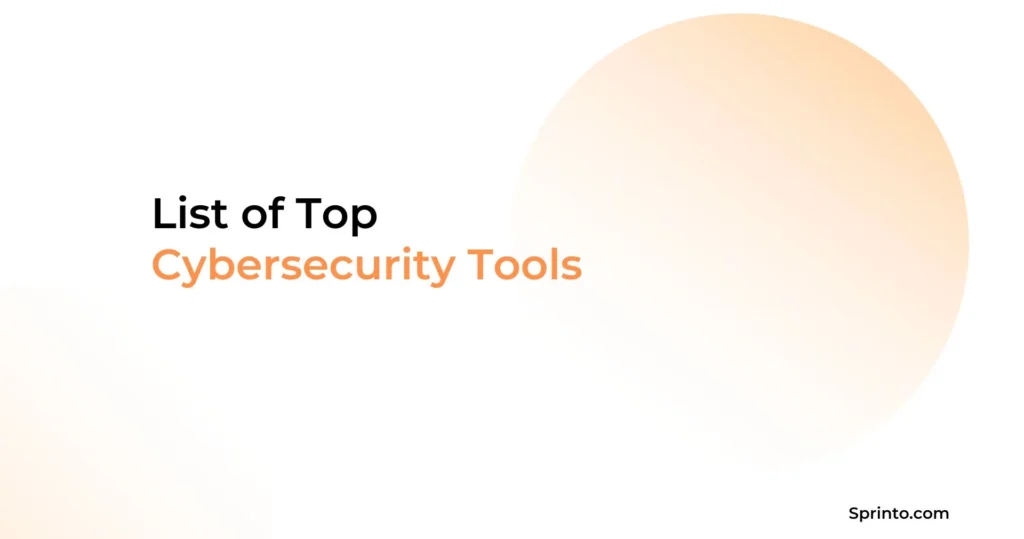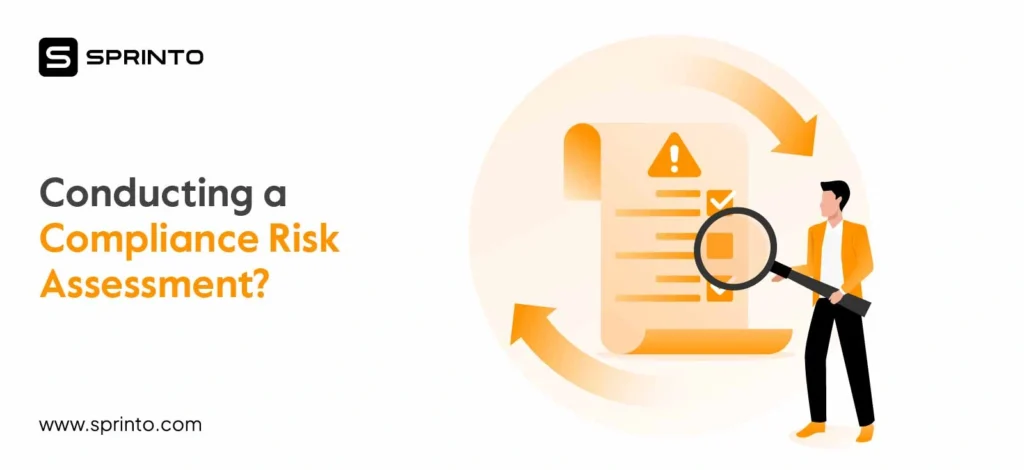Compliance platforms like Sprinto and OneTrust simplify achieving compliance standards like SOC 2, ISO 27001, GDPR, and more. The challenge is immense: juggling multiple frameworks, battling redundant tasks, and preparing for audits without slowing down operations. The platforms become critical enablers for growth and trust. However, they take very different approaches.
| TLDR: Sprinto is an automation-first, continuous compliance platform built for fast-growing tech companies to achieve security certifications with minimal manual effort. OneTrust, on the other hand, is a broad GRC and privacy management suite geared towards enterprises that need comprehensive data privacy, governance, and risk management tools. |
| Sprinto stands out for ease of use, real-time monitoring, and deep automation, while OneTrust offers extensive features at the cost of greater complexity. |
| Choose Sprinto for a streamlined, scalable compliance automation experience, and OneTrust if your organization requires a wide-ranging privacy and GRC platform. |
What Does Sprinto Do?
Sprinto is a continuous security compliance platform designed to help companies achieve and maintain certifications without the heavy lifting. Sprinto integrates with your tech stack: cloud platforms, code repos, HR systems, etc. It automates the tedious work of collecting evidence and monitoring controls, alerting you to compliance gaps.
The platform ‘productizes’ compliance requirements, turning them into automated checks and workflows. Sprinto has a library of pre-mapped controls, templates, and policies aligned to common standards, so you’re not starting from scratch.
For example, when pursuing an SOC 2 certification, Sprinto provides all the required controls, policies, and even out-of-the-box employee security training modules. It then continuously monitors those controls 24/7, detects anomalies or deviations from compliance, and triggers remediation tasks automatically. This makes compliance a part of daily operations, not a once-a-year scramble.
What Does OnTrust Do?
OneTrust is a comprehensive platform designed to help organizations build and demonstrate trust, measure and manage risk, and move beyond compliance. It offers a broad suite of solutions across various GRC and privacy domains, catering to different organizational needs.
OneTrust provides features like privacy impact assessments, data mapping and discovery, consent management, incident management, third-party risk management, and even AI governance. OneTrust’s ‘Tech Risk & Compliance’ solution offers automation for security frameworks, risk registers, and compliance workflow automation. It includes ready-to-use frameworks with mapped controls and evidence requirements broken into tasks. It also supports 200+ integrations and a unified platform to connect teams across privacy, security, and compliance functions.
Major Considerations when choosing between Sprinto and Onetrust
Choosing between Sprinto and OneTrust comes down to understanding your organization’s priorities and constraints. Here are some significant factors to consider:
Scope of Compliance Needs
If your primary goal is to achieve security certifications (like SOC 2, ISO 27001, HIPAA) and maintain them with minimal fuss, a focused tool like Sprinto will serve you better. Sprinto specializes in these frameworks and automates them to a high degree.
However, if your scope extends to managing multiple privacy laws and broader governance at an enterprise level, OneTrust’s broader suite might be better.
Company Size and GRC Team Maturity
Sprinto is ideal for lean teams, including startups without a dedicated compliance officer. It has built-in guidance, templates, and an intuitive interface that allow small—to mid-sized tech companies to get audit-ready quickly without scaling up GRC staff.
OneTrust, on the other hand, is better suited for enterprises with established GRC, privacy, or security teams. Its extensive customization options can be powerful but require dedicated resources to manage effectively.
Ease of Use vs. Customization
Sprinto prioritizes usability with a clean interface and pre-automated workflows that streamline onboarding and audits. If you need fast deployment and an easy learning curve, Sprinto is the better option.
OneTrust offers greater customization and flexibility, which is valuable for complex setups—but it comes at the cost of a longer setup and steeper learning curve.
Depth of Automation
While both platforms offer automation, Sprinto is automation-first. It handles up to 90% of evidence collection and control monitoring with continuous real-time checks. It’s built to minimize manual effort and ensure proactive remediation.
OneTrust includes automation capabilities like workflow triggers and task assignments but may require more hands-on configuration and upkeep. Its strength lies in providing a unified governance experience rather than fully hands-free automation.
Sprinto’s continuous control monitoring is a significant advantage. OneTrust’s strength is a unified workflow and content library across many areas, rather than completely hands-free automation in each. Consider how much automation you need versus how much you expect your team to manage manually.
Integrations
Sprinto integrates with 200+ systems: cloud platforms, DevOps tools, HR systems, device management, and more. This helps pull evidence automatically. OneTrust’s integrations span IT systems and things like cookie consent tools and data discovery tools within its ecosystem.
If you have a very developer-centric stack and want a developer-friendly tool, Sprinto, designed for tech companies, offers a custom API and integration flexibility. OneTrust’s integrations are broad and include more enterprise apps, which are helpful if your compliance overlaps with broader ITSM or marketing systems.
Pricing and Cost of Ownership
Pricing details for both platforms are quote-based. OneTrust is an enterprise-grade solution where features like privacy or GRC may be billed separately. Implementation can also add to costs.
Sprinto offers a more streamlined cost structure, with most compliance features bundled into a single offering. While it may appear more expensive upfront, the total cost of ownership is often lower, thanks to reduced resource usage and audit prep time.
User Experience and Support
Sprinto aims to be your compliance partner, providing both software and support. Their live chat help and compliance experts help customers through tricky requirements.
OneTrust is a larger company that offers support and a help center, but support for complex issues can be slow or require escalation. If a good support experience is essential, Sprinto has an edge in customer success.
Supported Frameworks
Sprinto and OneTrust support multiple compliance frameworks, but the breadth versus depth of that support differs.
| Feature | Sprinto | OneTrust |
| Frameworks supported | All major frameworks | All major frameworks |
| Key Certifications | SOC 2, ISO 27001, HIPAA, GDPR, PCI-DSS | SOC 2, ISO 27001, HIPAA, GDPR, PCI-DSS |
| Global Privacy Regulations | Supports GDPR, CCPA, CPRA, etc. | Similar coverage GDPR, CCPA, CPRA, etc. |
| Custom Framework Support | Yes, bring your framework | Yes, full control mapping is available |
| Cross-Framework Mapping | Yes – common control reuse across standards | Yes – requires manual configuration |
| Specialty Standards | NIST, CIS Controls, FedRAMP, CSA STAR | HITRUST, NIST 800-53, ESG, etc. |
Key Features
Let’s compare some key features and capabilities of Sprinto and OneTrust side by side to highlight what each platform offers.
| Feature | Sprinto | OneTrust |
| Continuous Monitoring | Real-time, automated drift detection | Yes, with custom workflows and configuration |
| Audit Management | Integrated audit hub, real-time evidence, multi-framework | Project-style audits with templates and task-tracking |
| Risk Management | InfoSec risk with auto-notifications | ERM, vendor risk, IT risk, mapping across assets |
| Policy & Training | Built-in policies and employee training | Available, often as separate modules |
| Vendor Risk | Security questionnaires, vendor tracking | Full TPRM workflows, including scoring and remediation |
| Trust Center | Included in the core platform | Available |
| AI & Innovation | Rapid feature rollout, LLM-based automation | Strong roadmap, slower rollout across multiple modules |
Sprinto vs Onetrust: Which is better for your business?
Both platforms satisfy many scenarios, but each has its sweet spot. Let’s break down who benefits most from each platform.
Choose Sprinto if:
- You need fast, hassle-free certifications
Sprinto automates evidence collection and control checks, helping you get audit-ready for SOC 2, ISO 27001, or HIPAA with minimal effort. - You’re a tech-forward SMB or mid-market company
Designed for agile teams, Sprinto scales with fast-growing SaaS and cloud-native businesses without adding operational drag. - You want deep automation
Sprinto auto-maps controls, gathers evidence, and reduces engineering and IT overhead, eliminating manual compliance work. - You plan to pursue multiple frameworks
Sprinto lets you reuse controls and evidence across standards like SOC 2, ISO, and GDPR, future-proofing your compliance roadmap. - You want hands-on support
Sprinto’s compliance experts guide you through every step, with consistently high support quality and responsiveness ratings. - You prefer simplicity and predictable costs
Sprinto offers a unified platform with no hidden fees or disjointed modules, reducing complexity and the total cost of ownership.
Choose OneTrust if:
- You need a comprehensive, enterprise-grade GRC suite
OneTrust supports privacy, vendor risk, ethics, and ESG, which are ideal for large enterprises with complex regulatory needs. - Privacy is a top priority
With tools like data mapping, cookie consent, and DSAR workflows, OneTrust is purpose-built for robust data governance. - You have a dedicated team to manage the platform
OneTrust is powerful but complex, and it is best suited for organizations with the time and resources to implement and maintain it thoroughly. - You need broader GRC capabilities
From vendor assessments to enterprise risk management and AI governance, OneTrust supports broad range of use cases.
Sprinto: From Reactive Burden to Strategic Advantage
For fast-growing, cloud-native businesses, Sprinto is the more intelligent choice. Its deep automation, rapid audit readiness, and intuitive experience help teams scale compliance without scaling overhead. Unlike heavyweight GRC suites like OneTrust, Sprinto is designed for agile teams that want to embed security into operations and turn compliance into a growth enabler.
If you’re looking for a platform that makes compliance seamless, efficient, and strategic, Sprinto is the best fit. Try it out today!
FAQs
- What is the difference between Sprinto and OneTrust?
Sprinto is purpose-built to automate security compliance for cloud-native companies. OneTrust is a broader GRC platform designed for enterprises that need to manage security frameworks and privacy, risk, and governance requirements at scale.
- What is the cost difference between Sprinto and OneTrust?
Sprinto offers a clear, predictable pricing model focused on compliance automation and is typically more cost-effective for small to mid-sized tech teams. OneTrust provides a modular, enterprise-grade platform, but costs scale quickly as you layer on privacy, consent, vendor risk, and tech risk modules—often landing in the $50k to 100k/year range.
- How long does it take to implement Sprinto vs OneTrust?
Sprinto typically gets teams up and running in days or weeks due to its plug-and-play design and guided onboarding. OneTrust implementations can take longer, often requiring dedicated resources and professional services for configuration.
Srikar Sai
Srikar Sai turns cybersecurity chaos into clarity. As a Senior Content Marketer at Sprinto, he cuts through the jargon to help people grasp why security matters and how to act on it. He’s particularly drawn to the intersection of tech and business. Outside of work, he does what most people do: a mix of the mundane and the occasionally exciting. Some days it’s trekking or exploring someplace new; some days it’s catching up on his favorite shows, tinkering with something random, or getting lost in whatever piques his curiosity.
Explore more
research & insights curated to help you earn a seat at the table.



